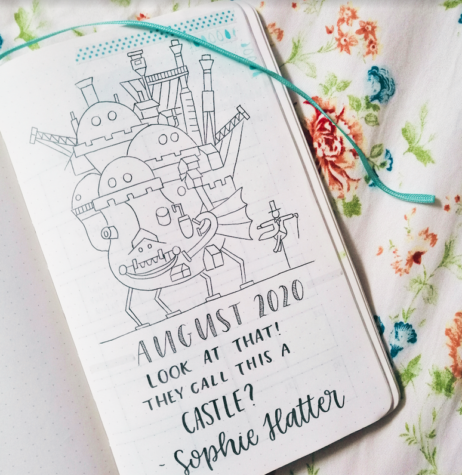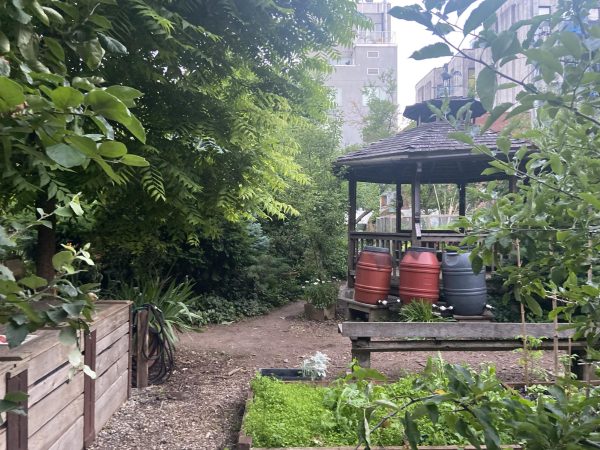How to Bullet for Beginners: A Profile on the Bullet Journaling Club
This club reveals how bullet journaling could be exactly what you need in order to get your life in order.
Here is a spread from the bullet journal of Mysha Rahman ’23, detailing the week’s to-do list.
Flowing script decorates pages of a journal and bright complimentary colors frame the ‘to-do list’ of a week. The pages are impeccably organized, each day separated into a seamless section of colored ink and tape. It’s a bullet journal, or a BuJo for short, carefully crafted by one of the members of the Bronx Science BuJo club.
The Bronx Science BuJo Club meets on Mondays in Room 328. During meetings, the members work on their BuJo skills, hone their intentions, practice small sketches aside from their bullet journals, and make vision boards. A writer on angelagiles.com defines a vision board, also known as a dream board, as “a collage of pictures, affirmations, and quotes of one’s desires and dreams.” Members of the BuJo club create these boards, a source of inspiration and motivation, in order to visualize the process of attaining their goals.
Bullet journaling may seem like a waste of time, an organizational tool that lacks convenience or use, solely focused on the aesthetics of dolled-up organization. But to Bronx Science BuJo Club President Subah Mehrin ’22 and thousands of others across the internet, the bullet journal serves as a useful tool that can be used to alleviate the stresses of life and work.
The conventional bullet journal serves as both a planner and diary. It is credited as a great tool to organize tasks, feelings, and goals into a single journal in order to improve productivity. “Bullet journaling is a creative way to express what you like in a journal through many art forms,” Mehrin said.
Andy Ouyang ’22, Vice President of the club, added, “BuJo is a creative process of organizing tasks to complete while maintaining creative freedom. While its original intent was more for productivity and keeping track of one’s life, it can be used for artistic expression, such as with doodles and calligraphy quotes.”
Ouyang recommends beginners to start by viewing YouTube videos to see how a bullet journal is set up and used. “The original ‘How to Bullet Journal’ video by the creator of BuJo, Ryder Carroll is a good place to start, because it gives you insight into the original method before deviating into your own method. You will quickly learn that there is no correct way to bullet journal; everyone makes their own system,” Ouyang said.
BuJo was created by designer Ryder Carroll, a digital product designer and author who resides in Brooklyn, New York. The inspiration of BuJo stems from his learning disabilities early in life, which hindered his productivity and his ability to focus. He developed BuJo as a way for him to achieve focus and to increase his productivity. The official bullet journal website that Carroll released refers to BuJo as a methodology. “It’s best described as a mindfulness practice disguised as a productivity system. The goal of the Bullet Journal is to help its practitioners live intentional lives, ones that are both productive and meaningful,” states Carroll on the website.
Mehrin elaborates on this point. “You get a bullet journal, and you kind of let your pen flow, and you also have an intention. Perhaps your intention is to be more productive or to write things down for your mental health,” she said.
The intention is the most important. For those who worry that they may not be creative or artistic enough to create colorful, aesthetic spreads of their ‘to-do lists’ and diary entries, the main point of BuJo is not the artistic aspect, but rather the journal’s function in helping individuals to reach their goals or intentions. “Bullet journaling is always about function over form, right? And to be very clear about that, form can mean sloppy or beautiful. It doesn’t matter what your bullet journal looks like. It’s about how it makes you feel, and how effective it is in moving you towards the things that matter to you,” Carroll tells lifestyle blog, goodhousekeeping.

The Secretary of the club, Mysha Rahman ’23, seconds this sentiment. “Don’t get too overwhelmed with making everything look nice,” she said when asked for tips for beginners. “First, start with what you need in order to keep yourself organized, and go from there.”
Ouyang has another tip for beginners. “Start out with the most simple supplies and work your way from there!” He recommends that beginners should “experiment with different styles in order to find the one for you. Take inspiration from social media, such as Instagram and Twitter. Do not be discouraged by a failed spread; instead, just start fresh again.”
How does one choose an intention? Mehrin discussed the creative freedom that the BuJo provides. “Your bullet journal is completely personalized by you. If you want it to be professional and related to your school work, then you can make it that. If you want it to be for all of the anime that you watch, then you can also make it that.”
Rahman explains more on what goes into a bullet journal. “Anything you want can be in your bullet journal; it just matters what your priorities are. Personally, I only use to-do lists, but other people use their journal as a place to vent or just to doodle.” The BuJo is also versatile and can be modified to fit each person’s needs. “I actually have many different bullet journals, each for different intentions,” Mehrin said.
Mehrin says there are many benefits of bullet journaling — it organizes your tasks, creates a better state of mind, and provides a place to doodle and to be creative. Bloggers express these same benefits online. Anna Russell from The New Yorker writes, “Bullet Journaling has grown into a global community, with subsets of every variation: BuJo for students, BuJo for mothers, BuJo for veterans, #menwhobullet. It has taken off on the Internet as a kind of mindfulness-meets-productivity trend that equates organized journaling with an ordered interior life.” Anyone can pick up bullet journaling.
Rahman explains her experience with the benefits of BuJo. “Bullet journaling just keeps me from being overwhelmed. Instead of worrying about all of the things that I have to do and instead forgetting some of them, I have found that writing it all down and checking something on a list makes the work much more manageable. Organizing is the big thing for me because I’m able to stay on top of all my work.”
Bullet journaling not only has organizational but also mental health benefits. A quick Google search of “mental health and bujo” reveals pages of results detailing how BuJo can help us manage our mental health, where authors like Kyle Nicolaides explain how BuJo helped them to improve their own mental health. Nicolaides, who had begun bullet journaling with the intention of monitoring his mental health during his fight against anxiety and depression, praises bullet journaling. “Bullet Journaling saved my brain…[it] continues to be my North Star and daily companion that goes with me everywhere. I use it religiously all the time to help unpack the moods, emotions, struggles, dreams, and events of my life,” Nicolaides said.
Mehrin elaborates on her personal experiences of the interaction between mental health and bullet journaling. “Bullet journaling for me was my place to let all my feelings go out. I write pages and pages of just rants and ‘thought dumps,’ and it helps me to relax,” she said.
Ouyang also explains how BuJo has helped him. “My bullet journal has been the companion to mark my steps on this world and light up the path ahead. With pending tasks every day, it has been my reminder to keep moving forward despite any challenges and roadblocks ahead. Even when I am stressed, I try to bullet journal a bit to make everything less confusing. It helps relieve my stress when I start doing something relaxing in my BuJo like writing a calligraphy quote or doodling,” Ouyang said.
Bullet journaling for improved mental health isn’t only encouraged by BuJo bloggers and Bronx Science BuJo club members, but also by medical professionals. In a study published in 2013, 40 people with major depressive disorder were given bullet journals, in which they engaged in writing about events that either evoked strong emotion or events that did not provoke an emotional response. The results showed a significant decrease in depression for those that wrote about emotional events. According to the University of Rochester Medical Center, bullet journaling for mental health improves stress management and decreases the severity of anxiety disorders and some mood disorders.
The idea that BuJo is a viable tool to help Bronx Science students organize their work load, have a safe space to express themselves, and improve their mental health seems too good of an opportunity to pass up. “All you have to do is write down your plans for the day or month instead of just thinking about it,” Rahman said. So why not give it a try? Join the BuJo Club at one of their meetings to polish your intention, and to receive help for setting goals and bullet journaling tips!
The idea that BuJo is a viable tool to help Bronx Science students organize their work load, have a safe space to express themselves, and improve their mental health seems too good of an opportunity to pass up.
Olivia Wronski is a Features Editor for ‘The Science Survey.' She finds that journalistic writing is a great way to tell the stories of unique individuals...











